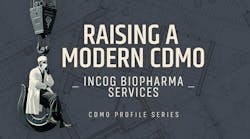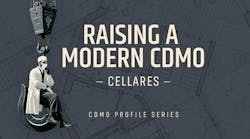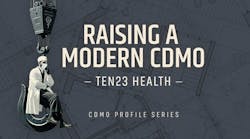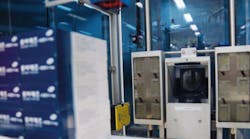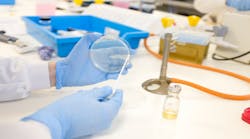Increasing costs, high prices for raw ingredients and tremendous competition have forced many U.S. pharmaceutical and nutritional supplement companies to outsource significant elements of their business processes. Historically, what was traditionally a domestic industry is now global — one that relies on suppliers, contractors, manufacturers and researchers.
The need to reduce time-to-market, boost drug discovery and squeeze costs out of pharmaceutical and nutritional products have forced U.S. companies to look elsewhere for raw materials, active pharmaceutical ingredients (APIs) and manufacturing and packaging services. Over the past several decades, the sourcing of pharmaceutical products migrated first to Europe and then to Asia, namely India and China. Recently, the production of a variety of dosage forms, including capsules, tablets and injectables followed suit, migrating to India and China.
Cost reduction is not the only reason for the observed increase in outsourcing to Asia. In 2006, more than 90% of the major pharmaceutical revenue was obtained from drugs that were on the market for five years.1 The patents on many of these products are soon to expire, exposing up to $157 billion worth of sales to generic drugs.1 Fewer new drugs are being produced than ever before, even though twice as much money is being invested for drug development, probably as a result of the U.S. government’s purported over-regulation of these new chemical entities (NCE). This patent expiry “cliff” has driven companies to consider new ways to increase drug discovery efficiency and improve profit margins by reducing manufacturing and material expenses. The patent expiry issue has enticed foreign competition as well. In fact, government-sponsored financial incentive programs in China and India are in place to help offset the imposed FDA user fees required for submitting New Drug Applications (NDAs).
Protecting Quality
Outsourcing has its challenges, particularly regarding all matters concerning FDA Quality Assurance requirements (QA). Although not a focus here, regulatory issues are also a concern when considering outsourcing drug development and manufacturing. The regulatory landscape in China and India is uneven and unpredictable. Protection of intellectual property in some Asian countries is difficult and has yet to meet western standards.1
Quality assurance of pharmaceutical products and nutritional supplements is important in every phase of development and manufacturing. For outsourcing to be successful, there needs to be a supply of essential medicines of excellent quality, safety and efficacy. Absolute confidence in the quality of supply and service is critical. Quality assurance in pharmaceutical drug development (including nutritional products) and manufacturing includes all factors that influence the quality of a product.2 Proper QA must ensure that the products are of the highest quality required for their intended use. Similarly, QA incorporates all aspects of Good Manufacturing Practices (GMPs), Good Laboratory Practices (GLPs), Good Clinical Practices (GCPs), production and control of operations, use of correct starting and packaging materials and the incorporation of safe intermediates, bulk material and process controls such as testing, calibration and validation. The finished product must be correctly processed, checked, properly stored and handled. Any observed deviation must be reported, investigated and corrected. Quality evaluations must be conducted routinely to ensure continuous monitoring and improvement, and there must be a properly designed, implemented and routinely documented QA system. All parts of the QA system should be adequately staffed with competent personnel using suitable equipment and facilities to do the job.
Top Outsourcing Opportunities in Asia
According to an evaluation by PricewaterhouseCoopers LLP, China is the leading outsourcing destination followed closely by India.1 China and India are spearheading growth in the Asian pharmaceutical sector and this trend is expected to continue. Due to low prices, China is the top producer of raw materials and ingredients that are included in globally available drugs. In 2010, API sales exceeded $10 billion, increasing at an annual rate of 17.6%.1 The primary exports of Chinese API and bulk ingredients include antibiotics, vitamins, amino acids and other organic materials.1 For example, the attractiveness for API manufacturing in China has convinced AstraZeneca to increase their outsourcing investment in that country.
The company has a dedicated outsourcing center in Shanghai and will use this center to make purchases — saving 10% over the next few years.1 In 2010, AstraZeneca’s total purchases were valued at $100 million. While China continues to build their finished dosage form business, it still lags other Asian countries in this area of expertise. Presently, India is the leading dosage form exporter to the United States. Chinese finished drug exports are estimated to be about $700 million, including the work completed by contractors and generated by new patent holders.2
India is one of the largest and lowest cost producers of generic drugs globally.1,3 Finished generics supplied from India account for nearly 20% of the global generic marketplace.1 In 2010, finished product sales exceeded 6 billion, increasing at an annual rate of more than 10%.1 Therapeutic drugs, as opposed to nutritional products, have driven these sales.
These include antibiotics, anti-infectives, anti-inflammatory drugs, cardiovascular drugs, central nervous system drugs and anti-diabetic drugs. India also contributes expertise in the production of a variety of complex dosage forms. Recently, the priority of drug research has been refocused from the reverse engineering of generics to research involving NCEs.1
India has excellent technology, R&D, production facilities and clinical research centers. Conducting clinical trials represents a significant portion of drug development costs and is time consuming. The availability of a large number of potential study subjects has attracted pharmaceutical companies such as GlaxoSmithKline and Eli-Lilly to conduct clinical trials in India.3 Typically, it is 40-50% less expensive to conduct clinical trials in India compared to western countries. Patients also can be recruited in less than one-third the time than in the United States during similar patient recruitment activities.1
Optimizing Quality in China
The FDA requires regular audits for all off-shore suppliers of drugs and drug products. However, outside the United States, few audits are completed due to a lack of FDA resources. While this situation is improving (evidenced by the recent hiring of locally staffed FDA personnel), the problem still exists. Critics point out ethical issues citing instances of locally hired staff remaining loyal to their former local employers. In China, nutritional and pharmaceutical products are regulated by the State Food and Drug Administration (SFDA), the Chinese equivalent of the FDA. Chinese GMPs are issued and are similar to those in the United States and in the EU. In China, a manufacturer must obtain a GMP certificate in order to operate4, granted after completing a time-consuming series of inspections when the plant is initially built. However, after certification, routine follow-up inspections and “recertification” are rarely accomplished. Unlike the United States, in China it is the responsibility of management to monitor quality and validate the manufacturing procedures after certification. As a consequence, it is likely a majority of Chinese manufacturers would probably fail an FDA audit. After conducting numerous FDA-style audits in China, we have yet to find a supplier free from issues.5 Of these issues, some can be easily corrected while others may require rebuilding the facility.
Based on personal experience working with a variety of Chinese factories, APIs and bulk materials that meet the high quality standards needed for sales in the United States can be found in China. However, finding reliable sources is difficult and requires considerable effort. Most APIs and bulk products are purchased through import/export agents and brokers who invariably have a vested interest in selling these materials regardless of where they have been produced.
Sometimes more than one supplier is used to produce the same product clandestinely.
Quality is not always consistent and a given supplier may use unacceptable GMPs. A U.S. firm must continually check the suppliers to ensure that QA standards are being met and that changes have not been implemented in the manufacturing process that may jeopardize the quality and safety of the product. Auditing and unannounced inspections are necessary and must be viewed as a critical component of a company’s policy. We recommend using auditors that are native speakers of the local language; such a person can more easily communicate directly to the production and laboratory personnel staff to ensure that all procedures are carefully followed. Buying products without first auditing and inspecting them is likely to result in problems. In China, the perception is that it is the responsibility of the buyer rather than the seller to ensure quality.
Some of the quality issues that Sancilio and Company encountered using U.S. independent auditors include:
- While appropriately trained employees were involved in the initial audits for plant certification, they were often replaced with new employees that were not well trained.
- Batch records were lacking/couldn’t confirm procedures used were identical to those specified in the contract.
- Laboratory testing was inappropriate or inadequate to ensure product quality.
- While new machines and procedures were initially validated, changes made after certification were not properly documented or validated.
- Cleaning records and validations were absent.
- Water systems did not meet U.S. purity standards. Rust, inappropriate welds, valves and filters were often used.
In Asia, it is critical to monitor carefully all aspects of product manufacturing to ensure that regulatory requirements are met and that safe and efficacious products are produced. To accomplish this, it is necessary to have a team of locally fluent, but U.S. trained, auditors and conduct unannounced visits at supplier facilities. Since most products imported from Asia are purchased through an import/export trading company, it is strongly suggested one hire a multi-lingual purchasing agent who can complete the required paperwork to facilitate import transactions. Working with a local English-speaking law firm is also highly recommended.
Interestingly, the Chinese government issues a “seal,” to use as a signature for legal documents. While signatures are legally binding in the United States, this seal is the legally binding mark in China. Thus, seals are extremely valuable and should be controlled by an independent, third-party attorney employed by the parent company in the United States. To monitor daily activities, weekly conference calls/meetings are a necessity, as are quarterly visits to corporate facilities.
Looking ahead, U.S. investment in China and India will continue to grow. With continued investment, there will be a gradual shift toward high-end drug discovery in Asia. Strategic partnerships and collaboration with companies in this region will be commonplace. The most successful companies will be those that successfully manage partnerships across a number of overseas locations while maintaining QA at the expected highest levels.
References
1. PricewaterhouseCoopers. The changing dynamics of pharma outsourcing in Asia. PricewaterhouseCoopers, 2008. http://www.pwc.com/gx/en/pharma-life-sciences/outsourcing/index.jhtml. Accessed January 2013.
2. Jia H. Chinese manufacturers vie for piece of outsourcing pie. Nature Biotechnology 2007;25:1337-1338.
3. Shukla A. Rationale behind biopharmaceutical outsourcing in India. Bio Outsourcing 2007;2:3-6.
4. Drug Administration Law of the People’s Republic of China, Chapter II, Article 9. http:/www.sfda.gov.cn. Acc. January 2013.
5. Sancilio FD, Spencer JJ, Newberger NC. Doing pharmaceutical, nutritional outsourcing in China and India: what problems may be encountered. Bio Outsourcing 2007; 2:30-32.
About the Authors
Dr. Ryan is vice president of clinical research for Sancilio and Company. He is involved with directing clinical research to evaluate the benefits of omega-3 fatty acids for a variety of medical conditions. Before joining Sancilio and Company, Dr. Ryan was employed at Martek Biosciences and at Abbott Laboratories. Email: [email protected]
Dr. Sancilio is the founder, CEO, and chairman of Sancilio and Company. He has more than 40 years of experience in the pharmaceutical research, development, manufacturing and distribution industries. Prior to founding SCI, Dr. Sancilio founded three pharmaceutical companies, including aaiPharma Inc. He has contributed to the development of over 1,000 drugs marketed in the United States, Europe and Asia.
Published in the February 2013 issue of Pharmaceutical Manufacturing magazine.
